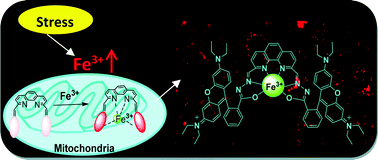A highly selective fluorescent probe for Fe3+ in living cells: a stress induced cell based model study†
Abstract
A rhodamine–phenanthroline dyad based fluorescent probe 4 has been designed and synthesized which selectively monitors Fe3+ ions among the various metal ions tested. Furthermore, probe 4 has been explored for monitoring of dynamic changes in the Fe3+ ion level under aggressive Fenton reaction conditions using a cell based model study. More significantly, probe 4 has also been utilized for real time imaging of endogenous Fe3+ ions in living C6 cell lines, the results of which demonstrated that probe 4 acts as an efficient fluorescent tool for Fe3+ ion detection in biological systems.



 Please wait while we load your content...
Please wait while we load your content...